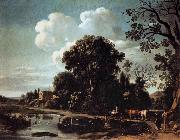Porslinet engros- Olja måleriet Engros- Måleriet Porslinet |
|||||||||||

|
|||||||||||
|
|
|
||||||||||||||
|
Filippo Napoletano
(c. 1587 - November 1629) was an Italian artist, with a peculiar output, mainly landscape and genre scenes and also drawings or etchings of diverse, often particular, items such as exotic soldiers, skeletons of animals, or cityscapes. He began his career in his native city, Naples (1600-1613) and moved to Rome in 1614-1617), where he appears to have encountered and felt influenced by the successful Flemish landscape painters such as Paul Bril, Goffredo Wals, and Adam Elsheimer. In 1617 Cosimo II dee Medici summoned him to Florence, where he worked closely with Jacques Callot. From notebooks, Filippo is known to have made hundreds of sketches of Tuscan landscapes and towns. Starting in 1620 he reproduced in etchings part of his collection of animal skeletons owned by Johann Faber, a Bavarian physician-naturalist residing in Rome and a member of the scientific Accademia dei Lincei. In 1622, Napoletano published twelve etchings of caprices (capprici) and military uniforms (which he signed as signed Teodor Filippo de Liagno). He is described by Giovanni Baglione as possessing a collection, a Wunderkammer of bellissime bizzarrie ("beautiful bizarre objects"), including among the objects exotic weaponry; fossilized plants; tiger, lion, and turtle skulls; oriental porcelain and sculpted crockery; a vest made of human skin; a harness for dragging whales on ice; a three-legged flea, Persian uniforms, and antiquities such as Roman coins, bronze lamps, and a few statuettes. After Napoletano death at Rome in 1628, bidding for such material was made by collectors such as Cardinal Ippolito Aldobrandini (future Clement VIII) and Cassiano dal Pozzo. |
||||||||||||||
|
|
||||||||||||||
|
||||||||||||||
|
|
||||||||||||||
| Filippo Napoletano
(c. 1587 - November 1629) was an Italian artist, with a peculiar output, mainly landscape and genre scenes and also drawings or etchings of diverse, often particular, items such as exotic soldiers, skeletons of animals, or cityscapes. He began his career in his native city, Naples (1600-1613) and moved to Rome in 1614-1617), where he appears to have encountered and felt influenced by the successful Flemish landscape painters such as Paul Bril, Goffredo Wals, and Adam Elsheimer. In 1617 Cosimo II dee Medici summoned him to Florence, where he worked closely with Jacques Callot. From notebooks, Filippo is known to have made hundreds of sketches of Tuscan landscapes and towns. Starting in 1620 he reproduced in etchings part of his collection of animal skeletons owned by Johann Faber, a Bavarian physician-naturalist residing in Rome and a member of the scientific Accademia dei Lincei. In 1622, Napoletano published twelve etchings of caprices (capprici) and military uniforms (which he signed as signed Teodor Filippo de Liagno). He is described by Giovanni Baglione as possessing a collection, a Wunderkammer of bellissime bizzarrie ("beautiful bizarre objects"), including among the objects exotic weaponry; fossilized plants; tiger, lion, and turtle skulls; oriental porcelain and sculpted crockery; a vest made of human skin; a harness for dragging whales on ice; a three-legged flea, Persian uniforms, and antiquities such as Roman coins, bronze lamps, and a few statuettes. After Napoletano death at Rome in 1628, bidding for such material was made by collectors such as Cardinal Ippolito Aldobrandini (future Clement VIII) and Cassiano dal Pozzo. between 1617(1617) and 1621(1621) Medium oil on canvas cyf |
||||||||||||||
|
Related Paintings to Filippo Napoletano :. |
||||||||||||||
|
|
||||||||||||||
|
|
||||||||||||||
|
KOMMA I KONTAKT MED Oss |







